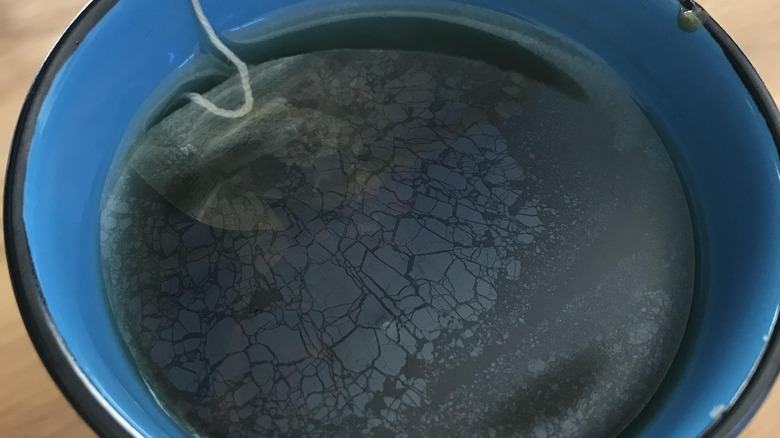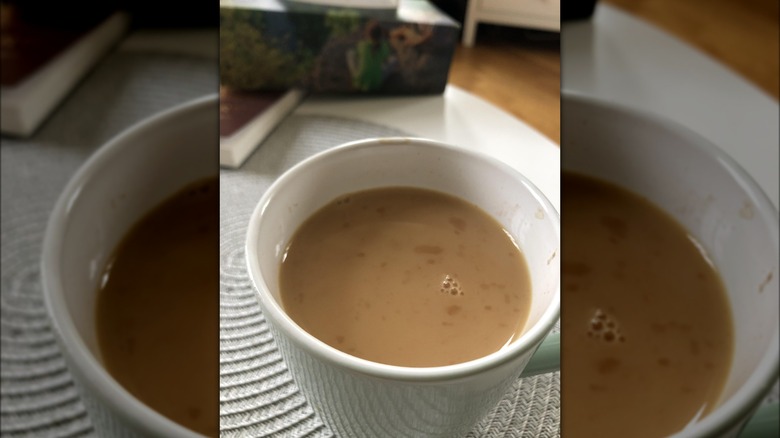Scientists Figured Out How To Prevent Film From Forming On Your Tea
If you spend every afternoon brewing your favorite type of tea, then you've no doubt run into a curious (and slightly icky) sight when preparing for your favorite beverage — after the drink has cooled, there's this greasy-looking layer floating on the drink's surface. When you stir the tea, the hazy layer will break apart into "chunks" that look like sea ice. Not only is it unsightly, but we're also certain that more than one person has been worried that their tea has been spoiled somehow when this "tea scum" appears.
The good news is that your tea is perfectly fine. Per a study in the journal Physics of Fluid, it's simply a byproduct of brewing tea using water that has a lot of soluble minerals in it, i.e. hard water. The chemicals in the tea react with these minerals, causing the film to form. While the film is an aesthetic problem only (it doesn't affect the taste or quality of the tea,) if it's been bothering you, scientists have fortunately found ways that you can get rid of this film for good.
The film is formed by hard water
Tap water, especially if it comes from a well, can contain traces of soluble minerals. If the concentration of minerals in your water is especially high (above 150 parts per million), then what you're using would be called "hard water." While harmless, the minerals can be a nuisance by forming white flakes in your tap water or, in this case, clouding up your tea.
When you steep your tea bags or loose leaves in hot water, in the first few seconds, you can see the essence of the tea leaking and darkening the water. In this mix, there's a class of chemicals called polyphenols. If the brewing water is rich in minerals like calcium carbonate (lime), the polyphenols from the tea will interact with them and form a thin film layer on top of the brew. This initial layer is too thin to be seen with the naked eye and requires special instruments to detect it while the tea is still hot. But after about 30 minutes of cooling, the film will become visible.
One of the key findings in the aforementioned study is that the thickness of the film correlates with the calcium level in the water. The harder your water is, the more prominent the film will form. If you really want to get rid of it, the best solution is to use filtered, soft water that has had its mineral content stripped — without calcium, the film won't form.
Use acids or sugar to dissolve the mineral film
If using hard water can't be helped, then there are tricks to thin out the film. One solution is to add a touch of acidity to your tea, like a few drops of lime or lemon juice to lower the pH of the tea. Lower pH levels, per the study, prevent the film from thickening. The acid won't eliminate the film entirely, but it'll keep it thin enough to be barely noticeable (unless you're scanning your daily cup of tea with advanced interfacial rheometry systems).
The other ingredients you add to your tea can also affect the film's formation too. Sugar acts like an acid in the sense that it helps thin out the film, while milk does the opposite and thickens it, even in small amounts. So, if you like your tea balanced with a small spoon of sugar, you'll rarely notice a film forming. Milky boba tea enthusiasts, however, aren't so lucky.
But don't worry too much about the film. At the end of the day, it's totally harmless, so just brew your tea the way you want. Worse comes to worse, you can just stir the tea to break up the film and continue sipping as normal. Or perhaps you can mix it into your oatmeal for an especially heavenly breakfast.


